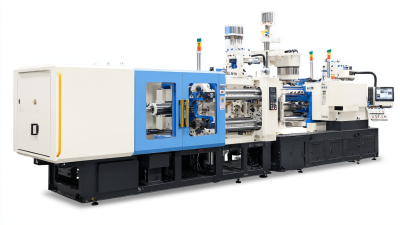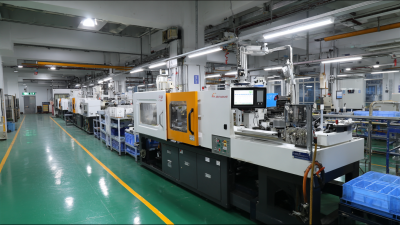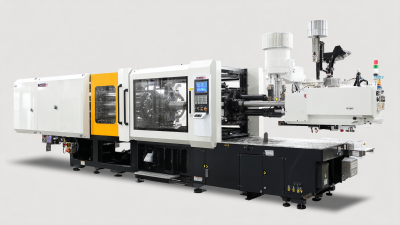Ultimate Injection Machine Comparison for Optimal Performance Selection
In today's competitive manufacturing landscape, selecting the right injection machine is crucial for optimizing performance and ensuring quality output. According to a recent report by MarketsandMarkets, the global injection molding machine market is projected to reach USD 17.73 billion by 2026, driven by the rising demand for precise and efficient production processes across various industries, such as automotive, consumer goods, and packaging.

However, the complexity of injection machine technology can lead to various issues, including inefficiencies, high operational costs, and inconsistent product quality. Understanding the potential problems associated with different types of injection machines is essential for manufacturers aiming to make informed decisions for their production needs.
This blog aims to provide a comprehensive comparison of injection machines, highlighting key performance metrics and common challenges to help stakeholders select the optimal solution for their specific applications.
Key Factors to Consider When Choosing an Injection Machine
When selecting an injection machine, investing in research and development (R&D) is pivotal for ensuring optimal performance and enhancing market growth. Companies that dedicate substantial resources to R&D can innovate more effectively, leading to superior machinery that meets the evolving needs of various industries. Key factors to consider when choosing an injection machine include technology advancements, energy efficiency, and the machine's adaptability to different materials. These elements not only improve the performance of the injection process but also contribute to long-term cost savings and environmental sustainability.
In the competitive landscape of manufacturing, understanding the specific requirements of your production line becomes crucial. Evaluating the machine's capabilities to handle complex designs and varying production volumes can significantly affect operational efficiency. Furthermore, with the ongoing trends towards automation and smart manufacturing, it's imperative to assess how an injection machine integrates with other technologies. This thoughtful approach to machine selection can lead to more streamlined processes and better product outcomes, ultimately fostering growth in the injection molding market.
Comparing the Efficiency of Different Injection Machine Technologies
When it comes to selecting the right injection machine, understanding the efficiency of different technologies is crucial for manufacturers aiming to optimize their production processes. Each injection machine type offers unique advantages, catering to various operational needs. For instance, hydraulic injection molding machines are known for their robustness and ability to handle larger, complex molds with high precision. Their efficiency largely stems from their high clamping force, making them ideal for heavy-duty applications.
On the other hand, electric injection machines are gaining popularity due to their energy efficiency and lower operational costs. By utilizing servo motors, these machines minimize energy consumption during idle times, thus significantly reducing overall production costs. Additionally, electric machines provide consistent performance and better control over the injection process, which enhances product quality. Meanwhile, hybrid machines combine the strengths of both hydraulic and electric technologies, offering flexibility and performance suited for diverse manufacturing environments. Understanding these differences in efficiency enables businesses to make informed decisions that align with their production goals and elevate overall performance.

Assessing Cost-Effectiveness: Investment vs. Long-Term Performance
In today's fast-paced world, the balance between cost and performance is more critical than ever, especially when selecting injection machines. The focus on long-term performance often reveals that initial investments can yield significant savings and benefits over time. A recent study highlights how technological innovations in mental health interventions not only present an upfront cost but also promise substantial long-term economic and social advantages. Similarly, when considering injection machines, evaluating their efficiency and sustainability can lead to better outcomes for businesses.
Tip 1: Always conduct a thorough cost-benefit analysis before procuring any equipment. Look beyond the purchase price to consider factors like maintenance costs, durability, and the machine's impact on efficiency. This comprehensive approach can help identify the most cost-effective options in the long run.
Tip 2: Investing in newer technologies may seem daunting; however, prioritize innovations that enhance performance while reducing energy consumption. For instance, just as advanced energy-efficient construction materials significantly lower energy demands, modern injection machines designed for optimal efficiency can translate into substantial operational savings over time.

Understanding Material Compatibility for Optimal Machine Selection
In the realm of advanced manufacturing, selecting the right injection machine hinges significantly on understanding material compatibility. The latest advancements in materials and manufacturing processes are driving market growth, particularly in fields demanding strong yet lightweight components, such as aerospace. A prime example is the development of space-qualified propellant tanks, which utilize high-performance materials to achieve greater durability while significantly reducing weight. This evolution is crucial for enhancing efficiency in aerospace applications and aligns with the industry's push for sustainability.
When considering machine selection, it is essential to assess the compatibility of materials with your intended application. Innovations in materials, such as specialty alloys and high-strength polymers, offer unique properties that can meet specific performance requirements. For instance, they can withstand extreme temperatures and stress, making them ideal for demanding environments.
Tips: Always conduct a thorough analysis of material properties before finalizing your machine choice. Additionally, consider future trends in materials science, as keeping abreast of these developments will ensure that your manufacturing processes remain competitive and efficient. Lastly, maintaining flexibility in your machine capabilities can allow for easier adaptation to new materials as they emerge in the market.
Best Practices for Maintaining Peak Performance in Injection Molding Machines
Maintaining peak performance in injection molding machines is crucial for maximizing production efficiency and minimizing downtime. Regular maintenance is key; it ensures that all components operate seamlessly together. Operators should establish a routine inspection schedule, checking for wear and tear on critical parts such as nozzles, heaters, and screws. This proactive approach helps identify potential issues before they escalate, prolonging the machine's lifespan and ensuring consistent output quality.
In addition to routine checks, keeping the machine clean is essential. Accumulated debris can interfere with operations, affecting both the quality of the finished product and the overall performance of the machine. It is advisable to implement a cleaning protocol that includes not only the exterior but also the internal components. Use appropriate cleaning agents that are compatible with the materials being processed to avoid any unintended chemical reactions.
Lastly, proper calibration and adjustments play a significant role in sustaining optimal performance. Operators should be trained to recognize the signs of misalignment or incorrect settings. Regularly reviewing and fine-tuning machine parameters can lead to noticeable improvements in production efficiency and part quality. Implementing these best practices can greatly influence the longevity and performance of injection molding machines.
Related Posts
-

How to Choose the Right Moulding Plastic Machine for Your Manufacturing Needs
-

Maximizing Production Efficiency with Advanced Plastic Molding Machines
-

Global Quality Revolution How Chinese Moulding Plastic Machines Capture International Markets
-

Exploring Innovative Alternatives to Plastic Injection Machines for Modern Manufacturing
-

Comparing Efficiency and Cost: Mini Plastic Injection Molding Machines Vs. Traditional Methods
-

How to Choose the Best Home Plastic Injection Molding Machine for Your DIY Projects
